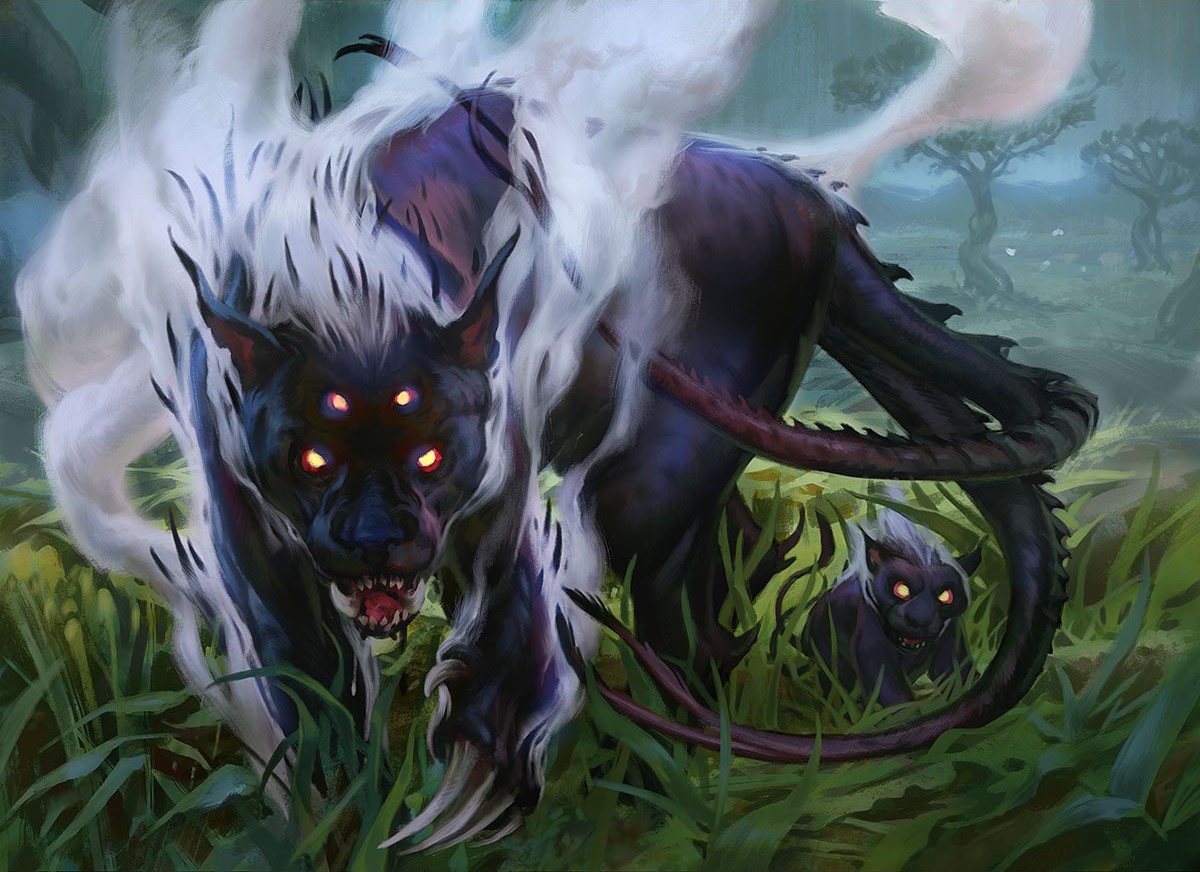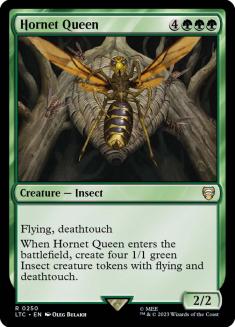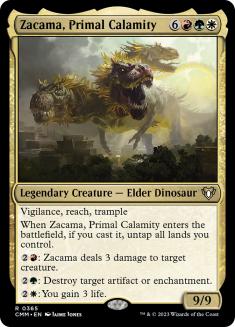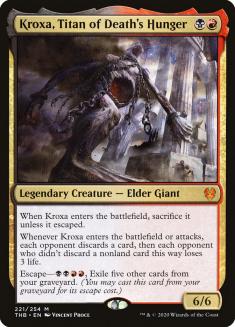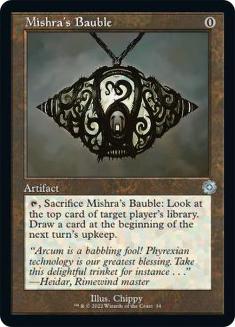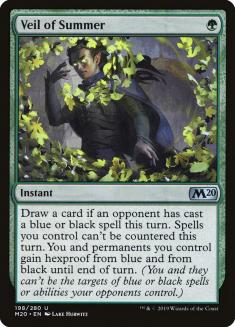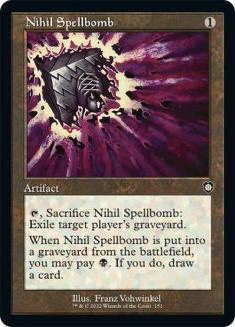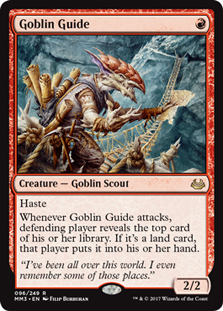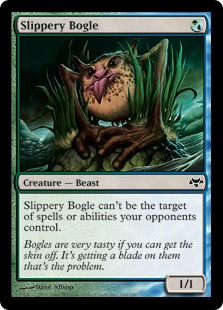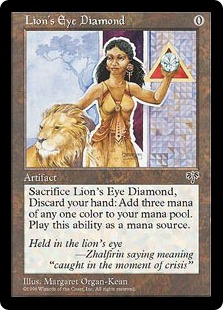Contemporary Magic decks do not play many silver bullets.
Those who remember the Birthing Pod decks of old will recall how they gradually removed all the sweet one-ofs, keeping only those that were extremely broad in application or fine cards outside of the relevant matchup. In Modern today, the most-played tutor is Summoner’s Pact. But Summoner’s Pact decks use the card primarily as four extra copies of Primeval Titan, and no longer bother with Hornet Queen or Zacama, Primal Calamity.
The reason for this shift is that players have realized that the cost of drawing their tutor targets naturally is far too high. Even though these cards are situationally incredible, drawing them in matchups where they’re bad is a massive downside.
Relics of a bygone age.
The few available tutors that allow you to find cards without including them in your maindeck, such as Fae of Wishes, avoid this problem. As a result, they remain highly played across all of Magic’s formats. The new companion mechanic from Ikoria: Lair of Behemoths allows you to cast the card it appears on once per game from your sideboard, provided you meet a deckbuilding restriction. This essentially allows you to start the game with eight cards, one of which is a free tutor for your chosen companion. Most of these restrictions are so onerous that even this incredible boon is not enticing. But one in particular strikes me as almost trivial to make work, a cool Cat by the name of Lurrus of the Dream-Den.
I try not to use hyperbole in my articles, so please believe me when I tell you: Lurrus of the Dream-Den is absurd. It will generally generate a card every turn it’s on the battlefield, often including the first. You do have to pay for the spells you’re casting, but (by requirement) they’re cheap enough that I do not see this as a huge downside.
I expect Lurrus to see play in Standard, Pioneer, Modern and even Legacy. The restriction on this card is easy to work around, and a significant number of successful strategies fulfill it already, especially in older formats, where very few cards that do not meet the restriction even see play. For some reason, the restriction only impacts permanents, so decks utilizing this card can still contain more expensive spells. That means decks which rely primarily on spells can utilize Lurrus to recur any inexpensive combo pieces they need. Did I mention that the card is a totally respectable 3/2 with lifelink to boot?
In Standard, Rakdos Sacrifice decks were already successful, and Lurrus’s ability has obvious synergy with such a gameplan. To maximize Lurrus, I’m basing my first deck off the Kroxa, Titan of Death’s Hunger lists, since the Titan provides an expensive end-game that naturally adheres to the deckbuilding restriction.
Creatures (29)
- 2 Rix Maadi Reveler
- 3 Gutterbones
- 4 Priest of Forgotten Gods
- 4 Dreadhorde Butcher
- 4 Cauldron Familiar
- 4 Mire Triton
- 4 Kroxa, Titan of Death's Hunger
- 4 Fiend Artisan
Lands (23)
Spells (8)

This deck can combine Fiend Artisan with Lurrus to repeatedly find and sacrifice Dreadhorde Butcher and Mire Triton. The loss of the card advantage provided in other builds by Midnight Reaper is compensated for by the eight-card starting hand, shaving a land, and adding a pair of Rix Maadi Revelers. With a curve this low and a desire to get excess lands into the graveyard, I think this deck might finally make that card seem effective.
In the sideboard, I have included several copies of Dead Weight, which this deck can cast every turn to really punish Mono-Red Aggro for cutting its Shocks. Additionally, Robber of the Rich and Agonizing Remorse capitalize on the low curve and shore up any weakness the deck has against control. The best part about this deck is that Elspeth Conquers Death, presently one of the most-played cards in format, hits only Lurrus. It should be easy to get value off the Dream-Den dweller before they can exile it.
In Pioneer, I think Lurrus can trivially slot into Mono-Black Aggro, since starting every game with eight cards is more valuable than having access to Rankle, Master of Pranks. After all, you need to draw that card for it to be good. This would also require swapping out Murderous Rider for Hero’s Downfall, but the overall exchange still seems worthwhile to me.
The more interesting question is whether Lurrus might find a home in Lotus Breach. Being able to, at any time, bring back an Underworld Breach from the graveyard for five mana is extremely valuable, not to mention that recurring Fae of Wishes can come up. However, this would require the deck to cut Vizier of Tumbling Sands, which is a significant cost.
In Modern, the thing I considered first with regards to Lurrus was Mishra’s Bauble. In combination with the zero-mana artifact, Lurrus draws an extra card every turn without much effort. Unfortunately, Lurrus’s restriction forbids Street Wraith and Emry, Lurker of the Loch, precluding most known Mishra’s Bauble shells. That said, Lurrus also works very well with Seal of Fire, which provides an enchantment type for Traverse the Ulvenwald and helps grow Tarmogoyf. Mix in a few copies of Thoughtseize and Wrenn and Six and there might be a grindy midrange Lurrus deck.
Personally, however, I am much more interested in using the card to add a grindy element to a fast and brutal archetype that needs just a little more staying power.
Creatures (12)
Lands (20)
Spells (28)

This deck can kill you extremely quickly, combining large creatures with sources of trample and pump spells to end the game before it begins. This aspect of the deck makes it favored against the various Primeval Titan decks of the format. In grindier matchups, it sideboards in Veil of Summer to protect Lurrus while you generate endless advantage with Baubles and Nihil Spellbombs. I expect this plan to be especially effective against traditional Jund, which is one of the most popular decks in the format right now.
The maindeck Spellbombs also incidentally answer Kroxa out of the current Jund lists and Uro, Titan of Nature’s Wrath out of Temur Urza decks. The fact that they also slow down Emry, demolish Dredge, and forestall Bedlam Reveler is just icing on the cake.
Modern decks like Burn and Hexproof can also play Lurrus at the cost of a single sideboard slot. Neither deck is that impressive right now, and it’s unclear to me if Lurrus changes that. However, the effect is strong enough that I would give them another look. Burn often wins games by a tiny margin, and a Lurrus plus a Goblin Guide when the deck is out of gas could make the difference.
Decks that would pay a higher cost to adopt Lurrus, such as Humans, should also experiment with it. I’m unsure if the card does enough to be worth losing Mantis Rider and Reflector Mage, but I wouldn’t be shocked if it did. Similarly, controlling decks can cut their planeswalkers and use Lurrus to recur Snapcaster Mage, Ice-Fang Coatl, and Mishra’s Bauble. Losing Teferi, Time Raveler and Uro, Titan of Nature’s Wrath is a huge cost, but there’s a real chance Lurrus is still better. Again, you have to actually draw those cards for them to be good.
The various creatureless combo decks in Modern could also play Lurrus, although neither Gifts Storm nor Ad Nauseam is a great fit. The issue is that Gifts Storm has trouble with the mana cost and doesn’t care much about recurring its creatures. Ad Nauseam, on the other hand, relies on Lotus Bloom and Pentad Prism for its fast mana, and neither plays well with Lurrus.
But in Legacy, it’s another story entirely.
Legacy Storm decks utilize an engine which occupies most of the deck, preventing them from sideboarding more than a few cards in any given matchup. Lurrus’s slot is therefore of relatively low value. In combination with Lion’s Eye Diamond, it can create two storm for the bargain-basement price of zero mana on net. This can turn games where you previously had to go for a risky Ad Nauseam into deterministic wins. It also creates four more Goblins with every Empty the Warrens and backs it up with a 3/2 creature to boot.
If you cast Lurrus the turn before you can go off, it will allow you to make six mana off a single LED. This allows the deck to play through a lot of commonly played hate cards: think taxing effects or Chalice of the Void on one. That’s not to mention the fact that you can just randomly cast it to pressure a planeswalker or force a control deck to tap out. According to friend of the show and Grand Prix Atlanta champion Cyrus Corman-Gill, this card is likely to appear in Storm decks for the foreseeable future. There’s even some chance of Lurrus appearing in low-curve Delver decks, although it is unclear to me how often those decks get targets in their graveyard and their sideboard slots are far more valuable.
So to recap: I expect Lurrus of the Dream-Den to see play in every major Constructed format in Magic. Decks that play the card will have the option to utilize it in every single game that they play, unlike any Constructed staple in the history of the game. Ultimately, I am unsure if I expect Lurrus of the Dream-Den to get banned. That said, I think it is clearly the most powerful card previewed at press time and if you told me one card from the set was going to pull an Oko, I would guess that it was this one.
Companion is an incredibly dangerous mechanic from a game design perspective due to the risk of repetitive gameplay, and the dream Cat might just turn out to be WotC’s worst nightmare.

